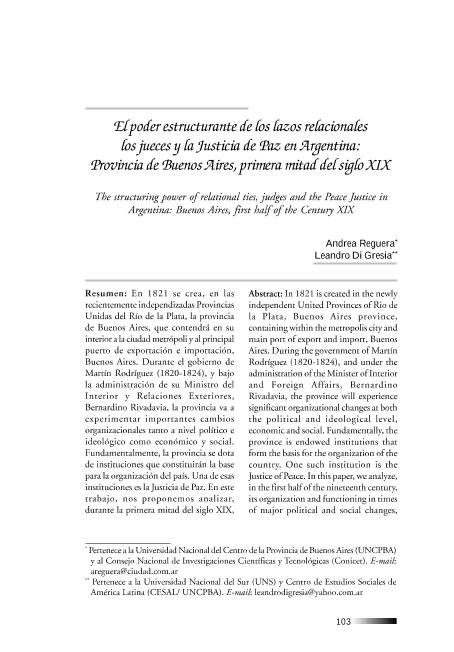Artículo
En 1821 se crea, en las recientemente independizadas Provincias Unidas del Río de la Plata, la provincia de Buenos Aires, que contendrá en su interior a la ciudad metrópoli y al principal puerto de exportación e importación, Buenos Aires. Durante el gobierno de Martín Rodríguez (1820-1824), y bajo la administración de su Ministro del Interior y Relaciones Exteriores, Bernardino Rivadavia, la provincia va a experimentar importantes cambios organizacionales tanto a nivel político e ideológico como económico y social. Fundamentalmente, la provincia se dota de instituciones que constituirán la base para la organización del país. Una de esas instituciones es la Justicia de Paz. En este trabajo, nos proponemos analizar, durante la primera mitad del siglo XIX, su organización y funcionamiento en momentos de importantes cambios políticos y sociales, expansión territorial y crecimiento económico. Para ello, por un lado, presentaremos las características de constitución y organización administrativa-institucional de la Justicia de Paz; y por el otro, a sus principales protagonistas, los jueces de paz, a quienes estudiaremos a partir de algunos casos puntuales, a fin de comprender el funcionamiento del orden estatal, tan lejos y tan cerca del centro neurálgico del poder central en Buenos Aires. Para ello, trataremos de ver quiénes eran, cómo eran elegidos y qué tipo de relación tenían con el gobernador. In 1821 is created in the newly independent United Provinces of Rio de la Plata, Buenos Aires province, containing within the metropolis city and main port of export and import, Buenos Aires. During the government of Martín Rodríguez (1820-1824), and under the administration of the Minister of Interior and Foreign Affairs, Bernardino Rivadavia, the province will experience significant organizational changes at both the political and ideological level, economic and social. Fundamentally, the province is endowed institutions that form the basis for the organization of the country. One such institution is the Justice of Peace. In this paper, we analyze, in the first half of the nineteenth century, its organization and functioning in times of major political and social changes, territorial expansion and economic growth. To do this, first, we present the characteristics of constitution and administrative-institutional organization of the Justice of Peace; and on the other, its main protagonists, justices of the peace, to study from some specific cases in order to understand how the state order, so far and so close to the nerve center of the government in Buenos Aires. To do this, try to see who they were, how they were chosen and what kind of relationship they had with the governor.
El poder estructurante de los lazos relaciones: Los jueces y la Justicia de Paz en Argentina (Provincia de Buenos Aires, primera mitad del siglo XIX)
Título:
The structuring power of relational ties, judges and the Peace Justice in Argentina: Buenos Aires, first half of the Century XIX
Fecha de publicación:
01/2014
Editorial:
Universidade de Caxias do Sul
Revista:
Metis: História & Cultura
ISSN:
1677-0706
e-ISSN:
2236-2762
Idioma:
Español
Tipo de recurso:
Artículo publicado
Clasificación temática:
Resumen
Palabras clave:
JUSTICIA DE PAZ
,
LAZOS RELACIONALES
,
BUENOS AIRES
,
SIGLO XIX
Archivos asociados
Licencia
Identificadores
Colecciones
Articulos(CCT - TANDIL)
Articulos de CTRO CIENTIFICO TECNOLOGICO CONICET - TANDIL
Articulos de CTRO CIENTIFICO TECNOLOGICO CONICET - TANDIL
Citación
Reguera, Maria Andrea; Di Gresia, Leandro Adrián; El poder estructurante de los lazos relaciones: Los jueces y la Justicia de Paz en Argentina (Provincia de Buenos Aires, primera mitad del siglo XIX); Universidade de Caxias do Sul; Metis: História & Cultura; 13; 25; 1-2014; 103-128
Compartir




